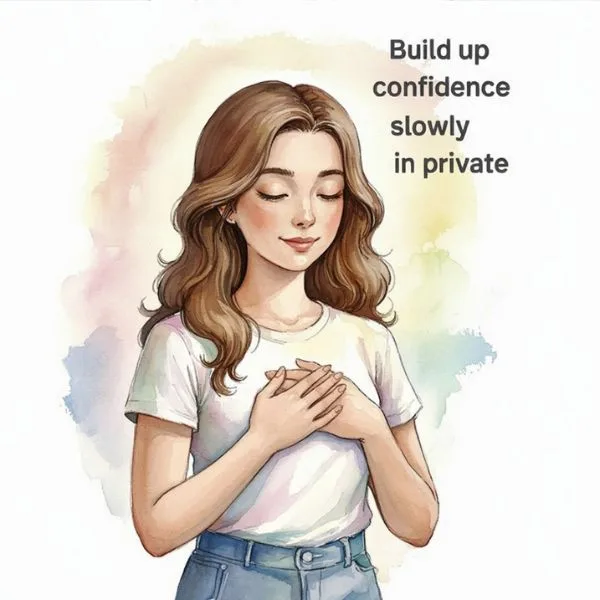Have you ever walked away from a conversation thinking, “I wish I’d said that better”? You’re not alone. The truth is, learning How to Communicate With Confidence is something we all need — in work, in relationships, and in daily life.
Maybe you froze during a job interview. Maybe you blurted out the wrong thing in front of your boss. Or maybe you stayed silent when someone crossed a line — and you regretted it later.
Communicating with confidence isn’t about being the loudest person in the room. It’s about staying grounded and clear — even in tense, high-pressure moments. With a few mindful shifts, anyone can build this skill. Let’s explore how.
1️⃣ Ground Yourself: Confidence Starts With Self-Assurance
Before words even leave your mouth, how you feel about yourself matters. When your mind is racing with self-doubt, it’s hard to speak clearly.
Tips:
- Take one deep breath before responding.
- Repeat to yourself: “I have value. My voice matters.”
- Pause. Then speak.
Tense Example:
You’re in a client presentation. Suddenly, your manager puts you on the spot: “Can you explain this part?” Your heart pounds — everyone is watching. Instead of panicking, you take a breath, tell yourself, “I know this content,” and calmly explain.

2️⃣ Posture and Presence: Your Body Speaks First
In tense moments, we often shrink: shoulders hunch, arms cross, gaze lowers. But how you physically show up speaks volumes.
Tips:
- Sit or stand tall, even if nervous.
- Shoulders relaxed, head up.
- Open posture — not defensive.
Tense Example:
At a heated parent meeting, another parent criticizes your suggestion sharply. You feel defensive. Instead of folding in, you sit upright, meet their gaze, and calmly reply, signaling that you stand by your view without aggression.
3️⃣ Tone of Voice: Speak With Warm Clarity
When tension rises, our voices betray us — we may sound shaky, too fast, or too sharp. Controlling your tone is key.
Tips:
- Slow down.
- Lower pitch slightly if voice feels shaky.
- Use pauses for impact.
Tense Example:
You’re calling customer service after being overcharged — and the agent sounds dismissive. Your instinct is to snap back. Instead, you slow your voice and say clearly, “I’d like this issue addressed properly — please connect me with a supervisor.” Calm tone = more power.
4️⃣ Choose Words That Match Your Intention
In tense situations, people often ramble, over-explain, or apologize unnecessarily. Simple, direct words signal confidence.
Tips:
- No need to fill silences.
- Use short, clear statements.
- It’s okay to pause and think.
Tense Example:
A friend pushes you to lend money, and you feel trapped. Instead of fumbling or giving excuses, you take a breath and say, “I’m not comfortable doing that.” No need to over-explain. Clear boundaries = strong communication.
5️⃣ Listen With Full Presence
When emotions run high, people often stop listening — they prepare their defense instead. But true confidence means staying present, even when it’s hard.
Tips:
- Hold eye contact.
- Nod or give brief verbal cues.
- Don’t interrupt — let them finish.
Tense Example:
During a performance review, your boss critiques your recent work. Your instinct is to interrupt or defend yourself. But you stay calm, listen fully, and respond only after they’ve finished — this often shifts the tone of the conversation and shows maturity.
6️⃣ Practice in Safe Spaces
Confidence in communication is like a muscle — it builds with practice. Rehearsing calm communication in lower-stakes situations prepares you for bigger moments.
Tips:
- Role-play with a friend: say no to unreasonable requests.
- Practice speaking up in casual groups.
- Volunteer to lead small discussions.
Tense Example:
You dread confrontation. So you practice with a friend: pretend you’re telling a neighbor they need to move their car from your space. After a few runs, you try it in real life — calmly and clearly — and it works. Confidence grows.

7️⃣ Build Confidence Like a Skill — Practice, Positivity, Persistence
Many people believe that confident speakers were “born that way” — but that’s a myth. Confidence is a skill you can build — just like learning to cook or ride a bike.
In his TEDx Talk, Dr. Ivan Joseph says it beautifully: “The skill of self-confidence is built through repetition, repetition, repetition.”
Tips to build your confidence muscle:
- Practice intentionally: rehearse saying difficult things out loud.
- Positive self-talk: replace “I’m bad at this” with “I’m getting better at this every time.”
- Learn from setbacks: reflect, adjust, and try again.
- Celebrate small wins: each success builds your inner proof.
Tense Example:
You freeze when networking at events. So you set a goal: say hello to 3 strangers at each event. The first few times feel awkward. But with practice — and by encouraging yourself — it gets easier. Eventually, initiating conversations feels almost natural.
Watch Dr. Ivan Joseph’s full TEDx Talk here:
Recommended Reading: Great Books on Building Communication Confidence
If you’d like to go deeper, here are some excellent books to help you strengthen your skills:
4 Essential Keys to Effective Communication in Love, Life, Work–Anywhere!: Including the “12-Day Communication Challenge!”
Communicate Your Feelings (without starting a fight): What to Say and What Not to Say to Your Partner (Mental & Emotional Wellness)
Related Post You May Like
If this post helped you, you may also enjoy:
👉Master Healthy Arguments: Your Guide to Better Relationship Conflicts
👉Better Conversations With Your Teen: A Communication Guide
Final Thoughts: You Can Communicate With Confidence
Confidence in communication isn’t about being perfect. It’s about staying calm, grounded, and clear — even when the pressure is on.
When you practice these simple shifts — breath, posture, tone, presence, and clear words — you’ll find yourself handling conversations with far more ease. And over time, even those “dreaded” moments become manageable.
You’ve got this.
Affiliate Disclosure: This post contains affiliate links. If you make a purchase through these links, we may earn a commission at no additional cost to you. Thank you for supporting Raise!


